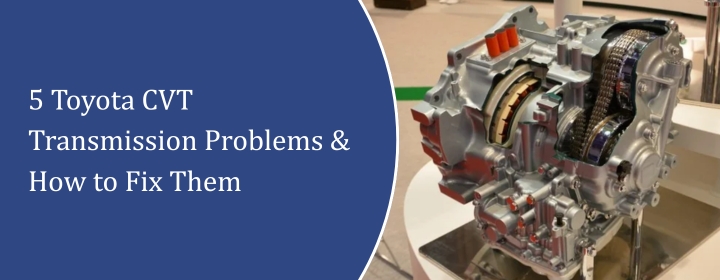
5 Toyota CVT Transmission Problems & How to Fix Them
Toyota is a reliable brand on which many drivers trust with no hesitation at all. You know you are behind the wheel of vehicle which is built to last, whether you own a Corolla or RAV4. However, it is reliable but not immune, especially when it comes to its CVT systems.
CVT transmissions are designed for smooth rides and improved fuel-efficiency. Unlike the traditional automatic transmissions, CVTs doesn’t rely on gear sets. Instead, they use a system of pulleys and belts for seamless power delivery. While it sounds like an engineering miracle, Toyota CVTs have had their fair issues over the years.
If you are facing any of these Toyota CVT transmission problems and consider a replacement, you will find many Toyota transmissions for sale within budget. Here in this blog, we will break down the top 5 Toyota CVT transmission problems; how to identify and how to fix it.
Shuddering and Jerking While Accelerating
The Problem:
One of the most common complaints from drivers is a perceptible shuddering or jerking when speeding up. Merging onto a highway makes the driving experience unsafe sometimes so uneasy due to this issue.
Why It Happens:
The jerking generally results from a worn or slipping CVT belt or contaminated transmission fluid. Over the time, the metal belt in the CVT system degrades or loses tension which leads to inconsistent power delivery.
How to Fix It:
- First, you need to check the condition and level of your CVT fluid. If it is dark in color or odour burnt then it needs replacement.
- If the fluid change doesn’t solve the issue, you may be looking at a worn-out belt or pulley system; you may need to visit to a professional mechanic or transmission specialist.
- Using OEM or high-quality aftermarket CVT fluid is very important. Subpar fluid can accelerate wear.
Overheating Transmission
The Problem:
Some Toyota CVT drivers have reported on certain overheating issues. These problems occur especially throughout long drives or high-temperature climates. Your transmission can go into “limp mode” because of how overheating reduces performance drastically
Why It Happens:
CVT transmissions generate a lot of heat and if the cooling system doesn’t function properly or if the fluid is old and not enough then it can’t dissipate that heat effectively.
How to Fix It:
- You should install an aftermarket CVT transmission cooler, especially if you live in a warm region or tow loads frequently.
- Replace old or contaminated transmission fluid every 60k to 100k miles but many experts advises sooner for CVTs.
- Keep an eagle eye on the temperature gauge and avoid overloading your vehicle.
Delayed Engagement or No Movement
The Problem:
When you put your Toyota in “Drive” or “Reverse” and there is a delay or worse which is no movement at all. This scenario is both alarming and dangerous.
Why It Happens:
Delayed engagement is typically a symptom of low transmission fluid, valve body malfunction, or internal clutch problems.
How to Fix It:
- You need to start with a transmission fluid level check. Top it up with Toyota-approved CVT fluid.
- If the issue is in fact still continuing, to check trouble codes that are related to the transmission control module, an OBD-II scanner is required.
- In severe cases, the Valve body may need replacement or a rebuild.
Whining or Grinding Noises
The Problem:
CVT issues can be often first noticeable through the presence of unusual noises. Whining, humming, and grinding could be heard by someone. Upon vehicle acceleration or deceleration, these sounds are more noticeable.
Why It Happens:
It can be occur when the CVT belt or pulley system is wearing out or if the transmission bearings are damaged. Low fluid levels also contribute to the problem by increasing friction.
How to Fix It:
- You need to top up or replace the transmission fluid. A fluid flush might help remove metal shavings and restore smoother operation.
- If noises persist, have a mechanic inspect the pulley and bearing system. Early intervention can prevent complete transmission failure.
Check Engine Light with Transmission Codes
The Problem:
Your check engine light turns on also after scanning of the code, the transmission-related trouble codes P0700 or P0796 are exactly what you see.
Why It Happens:
These codes are for signifying various CVT issues now. The codes include solenoid failure, pressure control problems, or electronic sensor faults due to these issues.
How to Fix It:
- A code reader and even an OBD-II scanner can help to identify the issues. It tells to you what the problem is. Once you have the code research it, or take it to a mechanic to diagnose it.
- Normal function may return since transmission solenoids are often swapped without total reconstruction.
- Toyota dealerships sometimes update software to fix electronic glitches instead.
Conclusion
From the above gist, we conclude that by recognizing the Toyota CVT transmission problems early and performing proper maintenance. You can extend the life of your transmission and avoid costly repairs. If you know what to look for puts you one step ahead, whether you are a DIY mechanic or prefer leaving the job to the professional mechanic. And in case if you need a replacement parts, car-partsusa.com has wide selection of CVT transmission components to get your Toyota back on the road.
FAQs
How often should I change the CVT fluid in my Toyota?
It is best to change CVT fluid every 30K to 50K miles to maintain the optimal performance.
Is it safe to drive with a shuddering CVT transmission?
Yes. It is safe to drive with a shuddering CVT transmission but ignoring Toyota CVT transmission problems can lead to more expensive repairs.
Can I use regular automatic transmission fluid in a Toyota CVT?
No. CVT transmissions require specially formulated CVT fluid. Using the wrong fluid can cause slipping, overheating, and premature wear.
